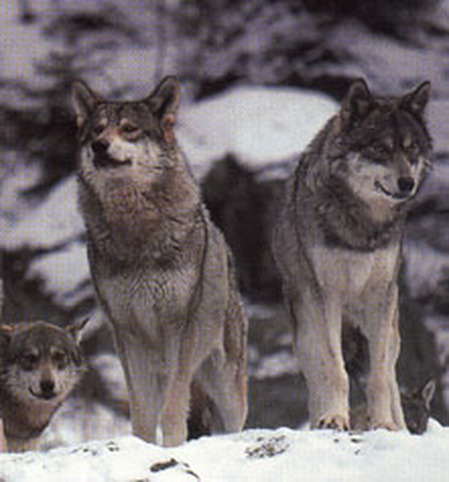Gray Wolves and their adaptations! :)
Gray wolves can survive in many biomes as long as there is enough food and the climate is cold enough. The Siberian Taiga, where these furry carnivores can be found, is a boreal forest with long, cold winters and short summers. It covers part of northern Russia, the place where wolves are very plentiful. The gray wolf is the largest wild canine. They are around 3 feet tall at the shoulder and are about 3 to 5 feet in length from nose to tail tip. Their weight ranges from 40 to 176 pounds.
The gray wolf has many special adaptations. Their coats are made up of wooly fur.This provides them with insulation. They also have long guard hairs to keep out the moisture. The gray wolf has large paws with fleshy pads and claws for traction which can also spread to provide some support in snow. Gray wolves have a hearing that is twenty times sharper than a human's and have a sense of smell that is also a hundred times keener. The wolf's jaws have a crushing pressure of over 500 pounds per square inch! Wolves' vision is very motion sensitive. They have a reflective retina, called a tapetum that makes their night vision extremely good although they can't see color. Wolves also have great stamina. They can cover a distance of more than eighteen miles at a quick trot. They have a top speed of about 40 miles per hour. These wolves are the worst nightmare for their pray!
The gray wolf has many special adaptations. Their coats are made up of wooly fur.This provides them with insulation. They also have long guard hairs to keep out the moisture. The gray wolf has large paws with fleshy pads and claws for traction which can also spread to provide some support in snow. Gray wolves have a hearing that is twenty times sharper than a human's and have a sense of smell that is also a hundred times keener. The wolf's jaws have a crushing pressure of over 500 pounds per square inch! Wolves' vision is very motion sensitive. They have a reflective retina, called a tapetum that makes their night vision extremely good although they can't see color. Wolves also have great stamina. They can cover a distance of more than eighteen miles at a quick trot. They have a top speed of about 40 miles per hour. These wolves are the worst nightmare for their pray!

